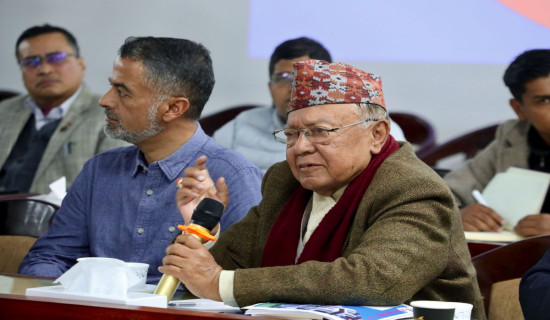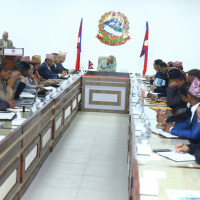- Tuesday, 23 December 2025
Breathing Peril: Kathmandu's Polluted Air
For the past few weeks, Kathmandu's skyline has looked more like a post-apocalyptic movie set than the capital of a marvellous Himalayan nation. Once renowned for its vibrant culture and landscapes, Kathmandu is now infamously known as one of the world's most polluted cities. Air pollution is silently threatening to pose health risks to its residents.
Air pollution refers to harmful substances in the atmosphere that pose risks to human health and the environment. Common pollutants include particulate matter, nitrogen dioxide, sulphur dioxide, carbon monoxide, and ozone. Among these, PM2.5, tiny particles with diameters less than 2.5 micrometres, are particularly dangerous. Common sources of PM2.5 include vehicle emissions, wildfires, dust storms, burning wood, construction and industrial processes, and power plants burning fossil fuel. The Air Quality Index (AQI) provides a numerical scale that combines several pollutants to gauge health risks. An AQI below 50 is considered good, and anything above 300 is hazardous. According to IQAir's 2025 World Air Quality Report, Kathmandu's AQI has frequently crossed 200 to 300 recently, placing it among the top ten most polluted cities globally. Other major cities like Biratnagar, Nepalgunj, and Dhangadhi have also seen AQI levels surpass 200, exposing millions to potentially dangerous air. This issue has become worse and unignorable.
Several factors have collided to create this air pollution threat. Rampant forest fires, particularly around the Kathmandu Valley and mid-hill districts, have engulfed the region in thick smoke. As of early April, over 100 active wildfires were reported nationwide, according to the Nepal Forest Fire Management Chapter. These fires are devouring forests and suffocating cities. A lack of rainfall this spring, which would normally wash away airborne particles, has allowed pollutants to linger. Experts say Kathmandu's bowl-shaped topography traps polluted air, delaying smog clearing. Emissions from old vehicles, brick kilns, and construction contribute to pollution. Additionally, cross-border pollution from northern India worsens the air quality of southern and eastern Nepal. Despite air quality regulations, enforcement remains inconsistent, and action is minimal.
A mapping review of 240 studies by Dominski FH et al. (2021) showed that air pollution significantly harms the respiratory and cardiovascular systems. Among the most frequently studied conditions were asthma, chronic obstructive pulmonary disease (COPD), and stroke. PM2.5, PM10, and nitrogen dioxide were the main culprits. The impact on the lungs can be immediate. Hospitals might see a surge in complaints of shortness of breath, wheezing, chest tightness, and persistent coughing. Children with asthma face dangerous exacerbations. Older adults with COPD often suffer from flare-ups that can even turn fatal. Even healthy individuals aren't spared—many experience burning eyes, hoarse voices, and sore throats. These are not just short-lived irritations. Prolonged exposure can permanently damage lung tissue and reduce lung capacity, increasing the risk of chronic respiratory diseases.
In March 2025, respiratory illnesses constituted over 30 per cent of outpatient visits in Kathmandu Valley hospitals, up from 18 per cent last year, according to the Department of Health Services. Research has increasingly linked air pollution to a myriad of health issues. A review published in an indexed journal documented an apparent rise in asthma exacerbations, chronic bronchitis, and reduced lung development in children due to air pollution. Furthermore, long-term exposure to PM2.5 causes increased hospitalisations for pneumonia, COPD, and lung cancer. A review by Behinaein P et al. (2023) found that the risk of non-small cell lung cancer among people exposed to heavy air pollution is higher, with a relative risk ratio of 1.54.
The effects of air pollution extend beyond the lungs, now recognised as a multisystem threat. Cardiovascular issues, such as heart attacks, strokes, and hypertension, are more common in those exposed to high levels of PM2.5. Polluted air increases blood thickness, triggers inflammation, and raises clot formation risk. Neurological studies indicate that long-term exposure to fine particulate matter may hasten cognitive decline, worsen mental health, and increase the risk of Alzheimer's disease. Children are especially vulnerable, with chronic exposure linked to anxiety, depression, and reduced attention spans. Pregnant women face higher risks of miscarriage, low birth weight, and premature delivery. Air pollution also irritates the eyes and skin, causing dryness and allergic reactions. A 2018 study by Saud B et al. linked air pollution to around 6.5 million premature deaths globally, which may rise to 7.5 million by 2040. It has also been associated with rising diabetes, obesity, and infertility rates due to hormonal imbalances. Pollution-driven climate change may also alter disease patterns and increase natural disaster frequency, as Manisalidis et al. (2020) emphasised.
While systemic change is crucial, individuals can reduce exposure and protect their health. Staying indoors during high AQI hours, wearing masks, and using air purifiers can help limit harmful particles. People with chronic lung diseases should follow prescribed medications and keep rescue inhalers and medications handy. Individuals can reduce private vehicle use, avoid open burning, and support green initiatives. However, these precautions are just temporary fixes. A coordinated effort is needed from governing bodies. The government must treat clean air as a public health priority—tougher vehicle emissions rules, phasing out old diesel engines, addressing construction dust, monitoring forest fires, planting urban greenery, and enforcing strict environmental regulations are key.
Regional collaboration is crucial in tackling this crisis. Nepal cannot solve cross-border pollution alone. It must work with neighbours on joint air quality targets and share satellite data on smoke. International support is vital for funding clean energy and large-scale air monitoring. Global problems need global solutions, and Nepal's skies are choking due to local carelessness and regional neglect.
Air pollution in Kathmandu and some other parts of the country is no longer a seasonal inconvenience but a growing public health crisis. This problem demands leadership, commitment, and action, not just promises. Our laws are not the issue; we have failed to enforce them. Citizens must demand accountability, and leaders must deliver results. The smog over Kathmandu is a looming threat. If we continue to ignore this thickening haze, we will not only lose the view of our mountains but also our future.
(The author is an assistant professor of Medicine, Baylor College of Medicine-Temple Campus, Texas.)
















